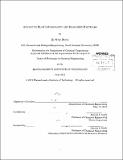| dc.description.abstract | Anisotropic multifunctional particles have drawn much attention, leading to wide ranges of applications from biomedical areas to electronics. Despite their enormous potentials, particles with geometrically and chemically complex patterns are not widely used because existing methodologies have limitations in large scale, facile production and suffer from constraints of functionality and morphology. For example, the geometries of multifunctional particles prepared by liquid-phase particle synthesis have been mainly restricted to spheres, deformed spheres, or cylinders. This geometrical restriction has resulted from the tendency of liquid systems to adopt arrangements that minimize surface energy. Although template-assisted particle fabrication can overcome this, these methods are largely ineffective at producing particles with chemical anisotropy or patterning, as the precursor liquid is simply isolated in a non-wetting template and then crosslinked in situ. Currently, a technique that can provide both geometrical and chemical complexities to particles has been missing. Distinguished with the above techniques, flow lithography (FL) has been emerging as a powerful synthesis tool that enables the creation of microparticles with complex morphologies and chemical patterns. Combining photolithography with microfluidic methods, FL has provided precise control over particle size, shape, and chemical patchiness. However, in the primitive versions of FL, particle geometry and chemical patterning has been restricted to 2D and 1D, respectively. Also, these techniques have required the use of polydimethylsiloxane (PDMS) devices, greatly limiting the range of precursor materials which can be processed in FL. Here, we present advanced flow lithography to achieve much higher degree of geometrical and chemical complexity than before. For example, lock release lithography (LRL) can be used to introduce three-dimensional (3D) morphologies, and provide chemical anisotropy in the x-y dimensions (in-plane dimensions) of particles. Also, hydrodynamic focusing lithography (HFL) was developed to offer z-directional (particle height direction) chemical anisotropy to particles. Lastly, oxygen-free flow lithography was a technique designed to extend current PDMS-based FL to any kinds of devices and allow for the creation of particles from previously inaccessible reagents such as organic solvents. In this thesis, we have also demonstrated advanced barcoded particles as one application of advanced flow lithography. Previously, barcoded hydrogel particles were created as a promising diagnostic tool for high-throughput screening and multiplexed detection of biomolecules. Utilizing advanced flow lithography, we have added advanced functions to the hydrogel particles introducing magnetic beads, tri-layered structures or near-infrared sensing materials. As the first advanced barcoded particles, we present magnetic barcoded hydrogel particles that had led to practical applications in the efficient orientation and separation of the barcoded particles. Also, we show reinforced barcoded particles that combine the usually orthogonal characteristics of an open porous capture region for biomolecule detection with strong structural properties that resist deformation in flow. Finally, we demonstrate near-infrared barcoded particles which can exhibit label-free and real time detection of target molecules. | en_US |
